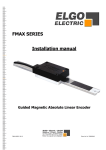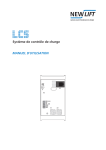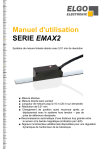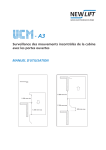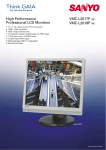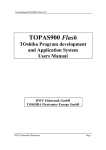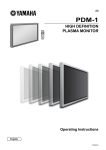Download Installation manual - SM Bown Electrical Ltd
Transcript
Installation manual Magnetic Absolute Linear Encoder positioning solution for elevator cabs Resolution 1 mm Up to 4 mm mounting distance to the magnetic tape Absolute measuring distance up to 260 meter Available as guided or unguided version No calibration or reference run necessary Direct measurement and installation at the elevator cabin No yo-yo effect Resistant against dirt (IP50 Standard) Easy to install Different interfaces available Power supply: 10... 30 VDC The magnetic tape can be hung vertically, spring loaded or mounted with a weight • Wear free, touchless and low noise measurement principle • • • • • • • • • • • • LIMAX2-000-E_36-06.doc Dok-Nr. 799000254 1. General 3 2. Safety instructions 4 2.1 Fault clearance 4 3. Assembly of LIMAX2 5 4. Operating state (LED - messages) 6 5. Dimensions 7 6. Interfaces and Protocols 8 6.1 CANopen - Interface (on demand) 8 6.2 SSI - Interface (standard) 9 6.3 RS-232 / RS-422 Interface (option) 6.3.1 RS-422 (version 1.4) ADRESSABLE (option A22) 10 10 7. Mounting possibilities 13 8. Oscillation Damper 14 9. Technical Specifications 15 10. Magnetic tape AB20-XX 16 10.1 Tape-construction “R – D” two components tape 16 10.2 Tape-construction “A” two components tape 17 10.3 Resistance against chemical influences 18 10.4 Technical specifications – magnetic tape 18 10.5 Sticking and cutting 19 11. Type designation LIMAX2 11.1 Type designation of magnetic tape (Accessories) 12. Liability exclusion / Guarantee 20 21 22 2 1. General bases on the already successfully in elevator applications used LIMAX Absolute Linear Encoder and it is possible to use the sensor with a mounting distance from 0,1mm up to 4,0mm to the magnetic tape with a resolution of 1mm (other resolutions on demand). The system is available as guided or unguided. As a result of an increased possible mounting distance of up to 4 mm a further advantage arises in the case of the guided version: During the measuring movement a substantially smaller noise of magnetic tape in combination with the guide plate develops. With the measuring lengths up to 260 meters can be processed. The measured „absolute” data (position) are transmitted to a super ordinate system (e.g. Control, SPS or PC) via Interface. There they can be processed then. The absolute linear encoder offers some crucial advantages: • • • • • • • • • • • no referencing necessary no data leakage after power failure space saving unit and simply installation direct measurement accurate positioning (no yo-yo effect) measuring distance up to 260m 1mm standard resolution (others on demand) operating speed up to 16 m/s Wear free, touchless and low noise measurement principle very resistant against dirt magnetic tape guiding plate from sliding special plastic The system can be assembled horizontally or vertically In the guided standard version the guiding plate guarantees the correct distance between the sensor and the magnetic tape. While with the unguided version of the LIMAX2 (option U) the correct mounting distance (0,1... 4,0 mm) – along the whole measuring section – must be ensured by the installation. For the mounting various accessories are available which simplifies the installation, they also complement meaningful the linear encoder. 3 2. Safety instructions Please note: Before first start up, read this installation manual carefully and observe absolutely the installation instructions. The measuring system is only dedicated for length measurements. The type label is intended for exact identification of the measuring system and is situated on the sensor housing. It informs about the exact type designation, the delivery date and the production number. When contacting the company ELGO Electric GmbH please use these terms. Attention! ELGO Electric GmbH is not liable for possible damages to machines or to persons, which can result from defective material at the measuring system and the connected units. The machine manufacturer is responsible for taking and realizing the necessary safety precautions. 2.1 Fault clearance The shielding of the signal cable should be connected only on one side with the further connected unit (e.g. PC or PLC). The signal output cable must principally be wired separately from heavy duty current wires and keep a distance of at least 0.5 m to inductive and capacitive interference sources as contactors, relays, engines, switch power packs, clocked controllers, etc. If there arise interferences in spite of observing all above described points, proceed as follows: Add RC elements over contactor reels of AC contactors (e.g. 0.1 µF / 100 Ω). Add recovery diodes over DC inductances. Add RC elements over each engine phase and over the engine brake (in the terminal box of the engine). Do not connect PE (potential earth) to GND (Ground) Connect a system filter at the external power supply 4 3. Assembly of LIMAX2 Three integrated Assembly-grooves at the sensor housing makes possible, a very simple and self-describing assembly. M6 hexagonal screw-nuts (according to DIN 933) or M6 square screw-nuts (according to DIN 562) can be inserted here, in order to fasten the system from the desired side to the desired place. Assembly-groove Active sensor area (at the unguided Sensor / option U): The active sensor area at the scanning side determines in the middle of the sensor and reaches along the whole case. When assembling therefore the following rule applies: Scanning side Æ Active Sensor area Assembly-groove magnetic tape Sensor center = mag. tape center (assembly tolerance = +/– 1 mm) Assembly-groove Attention! When sticking the magnetic tape, pay attention to the marker arrows on the magnetic tape and the sensor head. A faulty installation delivers incorrect measurement values! The marker arrows at senor and tape point to the positive counting direction! 5 4. Operating state (LED - messages) The front located LED´s serve for the monitoring of operating conditions. 33,40mm 17,20mm With startup it is to attend that the green LED shines, as this is monitoring the internal supply voltages. 22,00mm 19,00mm 16,80mm 11,60mm RED ON OFF Æ ERROR = status error, system not ready = status OK, system is ready YELLOW Æ Interface (state of interface) Flashes during the data communication GREEN Æ Supply Voltage ON = system ready to operate OFF = system switched off 6 5. Dimensions Rear Cover Topview 55mm 236mm Attention! The grey parts of the drawing and the grey dimensions apply to the guided version (standard) of the LIMAX2. 244mm 40mm 51mm 55mm Front Cover 40mm 51mm 55mm 7 6. Interfaces and Protocols 6.1 CANopen - Interface (on demand) The measuring system is equipped optionally with an CAN interface after CANopen standard. The following Identifier is given: Bit rate 250 KB/s CAN - Identifier (6 Byte telegram) 1A3 (16) = Identifier First 4 Bytes = position in mm (resolution 1 mm), Next 2 Bytes = speed in mm/s Because the system resolution is only 1mm and a average value formation is made, the smallest speed increment is 14 hexadecimal. With this increments the measured speed increases. Data protocol LSB xxh xxh xxh MSB xxh ABS-Position LSB yyh MSB yyh Speed Connections: Open wires (standard) color white brown orange yellow shield* function 0 V / GND + 24 VDC CAN low CAN high PE 9 poliger D-SUB Stecker (options DM oder DF) Pin Nr. function Pin 6 0 V / GND Pin 9 + 24 VDC Pin 2 CAN low Pin 7 CAN high shield* PE *) please connect the shield only at the machine side! 8 6.2 SSI - Interface (standard) Principle of the function: If the clock is not interrupted for the time Tm-T/2 (output of further 25 periods), the shift register clocks once again the same data value (error recognition in the evaluation). Some encoders contain a Power Failure Bit (PFB). Attention: With the LIMAX2 the PFB is alwas “LOW”! Data protocol: readout the data (with 25 clocks) T SSI - Takt 23 22 21 20 19 18 17 16 15 14 13 12 11 10 9 8 7 6 5 4 3 2 24 Datenbits/ 3Bytes 1 0 PFB PFB = Power Failure Bit T = Periodendauer des Taktsignals Tm = Monoflopzeit > 10µs Connections: Open wires (standard) color white brown violet grey yellow green shield* D-SUB 9 pin. Pin Nr. 1 2 3 4 5 6 7 8 9 NEWLIFT FST1 (D9M0) function Data + Clock 24 VDC 0V / GND Data Clock + PE function 0 V / GND + 24 VDC Data Data + Clock Clock + PE NEWLIFT FST2 (D9M1) function 0V / GND Clock + 0V / GND Data + 0V / GND + 24 VDC Clock Data VCC Masora Delta (D9M2) function VCC Data + Data Clock + Clock 0V / GND *) please connect the shield only at the machine side! 9 6.3 RS-232 / RS-422 Interface (option) If the measuring system is equipped with an RS232 or RS422 interface, the data communication has the following format: 9600 bauds 1 Start bit 8 data bits 1 stop bit no parity Data protocol: The measured absolute position will be represented with a resolution of 1mm in the three ABS-position data bytes. Version 2321 / 4221 STX 02h MSB xxh xxh LSB xxh MSB yyh ABS-position LSB yyh ETX 03h 00h 0Dh speed Version 2320 / 4220 STX 02h MSB xxh xxh LSB xxh ETX 03h 00h 0Dh STX = starts a message ETX = ends a message ABS-position Connections: Open wires (standard) color white brown violet grey yellow green shield* RS232 0 V / GND + 24 VDC TX RX PE RS422 0 V / GND + 24 VDC TX TX RX RX PE *) please connect the shield only at the machine side! 6.3.1 RS-422 (version 1.4) ADRESSABLE (option A22) Principle format of a message: to LIMAX2 STX 02h Byte 1 answer Byte 2 Byte check ETX 03h STX 02h Byte 1 Byte 2 Byte 3 Btye 4 STX = starts a message ETX = ends a message Check Byte = contains the arithmetic checksum of STX, byte1 and byte2 10 Position request of a LIMAX2 with the address „i“: to LIMAX2 STX 02h answer 04h i Byte check ETX 03h STX 02h MSB xxh xxh 04h = characterizes a message as position-request i = address of the requested LIMAX2 (0Bh – 7Fh) Bit 0 has the value 10µm, position-values are always lower than FFFF00h LSB xxh Adr. i ABS-position A LIMAX2 address request: Attach in each case only one LIMAX2 e.g. over a RS422/RS232 converter to the serial interface (COM-port) of a PC. to LIMAX2 STX 02h answer 05h 05h Byte check ETX 03h STX 02h FFh FFh i xxh ETX 03h 05h = characterizes a message as address request i = LIMAX2 address FFh FFh does not occur immediately after STX with position inquiries as answer! In this case i(0Bh <= i <= 7Fh) is the answer of the address request. Allocation of a LIMAX2 address: Attach in each case only one LIMAX2 e.g. over a RS422/RS232 converter to the serial interface (COM-port) of a PC. to LIMAX2 STX 02h answer 06h i Byte check ETX 03h STX 02h FFh FFh i+ 80h ETX 03h 06h = characterizes a message as address allocation i = the new LIMAX2 address. Important: At the answer you get the new address + 80h. The addresses 80h – FFh as well as 00h – 0Ah are FORBIDDEN. If you try to assign a address smaller than eight, LIMAX2 gives you a negative answer and keeps its former address. Important: Before you send a new message to the LIMAX2, wait for the answer first. After allocating a new address, the LIMAX2 answers in max. 0,5s and in a few milliseconds in other cases. After this time it is not expected to get an answer (transmission error). Negative Answer: If one of the described operations failed for some reason, LIMAX2 gives a negative answer with an concerning error – code. from LIMAX2 STX 02h FFh FFh ERR xxh ETX 03h ERR = Error-Code (04h – 0Ah) error – codes are listed at the next page 11 Error – Code meanings of an addressable LIMAX2: Code Meaning 04h Wrong succession of bytes sent to LIMAX2, for example if 4. Byte after STX is no ETX or the Byte after STX is not 0x04, 0x05 or 0x06. 05h Receive Error: Error concerning the interface (for example if there has been sent a message with a wrong baud rate etc.) 06h Invalid LIMAX2 address: appears after trying to assign an address smaller 0Bh or bigger 7Fh to LIMAX2. 07h LIMAX2 has forgotten its address: check of internal redundant stored address of LIMAX2 is failed. This message is sent at power up immediately if an error in reading EEPROM is detected or if the internal redundant stored address is not fit. 08h Internal EEPROM storage error. 09h Error in calculating the position (no tape, tape damaged or to big distance) 0Ah Check-Sum-Error: Check-sum of a message sent to LIMAX2 is wrong. Connection to a RS422 Master: RS422-Master LIMAX2-RS422 #1 LIMAX2-RS422 #n 12 7. Mounting possibilities The magnetic tape can be installed guided or unguided: Guided - hung vertically For a free-hanging assembly in the elevator shaft the guided sensor variant (standard) is used. For this a magnetic tape in construction R (standard) is hung up, parallel to the cabin, at the shaft ceiling and provided at the lower side with a weight for stabilization. Possibly lateral deviations along the measuring distance can be compensated by a guide plate with optional balance guidance’s at the bottom side of the sensor housing. The sensor passes the magnetic tape nearly contact free and in the correct mounting distance. In order to prevent an oscillating motion of the stabilization weight, a oscillation-damper should be attached above the weight. Unguided – Installation on a steel girder In the case of a mounting directly at a steel girder the unguided variant (U) is used, which differs only by the renouncement of the guide plate from the standard system. Here the sensor is fastened to the cab and passes the magnetic tape really contact free (preferably a tape in construction A). However it must be ensured with this version that the allowed mounting distance is not exceeded along the whole measuring distance. Owing to the own magnetization, the tape can be fastened without any mounting parts or sticky tape, directly at the steel girder. 13 8. Oscillation Damper If the magnetic tape should be assembled free-hanging, it recommends to stretch this at the lower surface with a weight from 5 kg. In order to avoid, that there oscillations develop and the magnetic tape together with the weight begins to oscillate there have to be a oscillation damper above the weight. The following picture demonstrates the mounting of such an application. Oscillation Damper Magnetic tape Weight for stabilization (5 Kg) 14 9. Technical Specifications Linear encoder Power supply voltage Current consumption Signal levels Repeat accuracy resolution Operating speed Measuring length 10... 30 VDC max. 0,2 A According to the interface specification +/- 1 Increment 1 mm (standard), others on demand max. 16 m/s max. 260 m gap sensor / tape max. 4,0 mm (on demand larger distances – up to 10 mm are possible. Therefore other tape pole lengths and a bigger housing design is necessary.) Working temperatur 0... + 60° C Operating temperatur - 20... + 70° C Stock temperatur - 40... + 85° C Humidity Not condensing, max. 80 % Operating height max. 2000 m above sea level Protection class IP 50: standard version IP 67: option V (sealed) Sensor Housing Aluminium (Al/Mg/Si 0,5) Dimensions See dimension drawing Cable Cable length Depends on bit rate and equipped interface min. bending radius 60 mm 15 10. Magnetic tape AB20-XX Coding and data of the magnetic tape (one track system): Basic data: Width of the magnetic tape = 10 mm Thickness of the magnetic tape ca. 1,5 mm 10.1 Tape-construction “R – D” two components tape In the standard case the magnetic tape is delivered as described here. The assembly takes place here via gluing on the respective mounting surface, it can also be assembled freehanging in the elevator shaft. A Scanning side Magnetized plastic tape (magnetic tape) B Magnetic leading steel band (Conclusion volume) Thickness: A + B = 1,5mm Available lengths: See technical specifications The magnetic tape consists of 2 components: A The magnetized, highly flexible plastic tape, connected on the lower side with: B Magnetic conductable and flexible stainless steel tape. It protects the plastic tape from mechanical damages and is a magnetic short circuit at the same time. This increases significantly the functional security under extreme magnetic influences. Both parts A and B are already factory-bonded (by ELGO). Alternatively the single components can be ordered separately (see type designation). 16 10.2 Tape-construction “A” two components tape Assembly at a steel girder, by the own magnetic attraction or by gluing: This deviating variant is delivered without the magnetic conductive steel band. Therefore the tape must be installed on a magnetic conductive surface, in order to increase the magnetic field strength. The magnetic tape can be stuck together here or alternatively fastened by its own magnetization e.g. on a steel girder. C Cover band for protection (unnecessary for measurement) Scanning side A Magnetized plastic band (magnetic tape) Mounting surface (e.g. steel girder) Thickness A + C = ca. 1,5 mm. Available lengths: See technical specifications These deviant version (see the type designation) consists of 2 components: A The magnetized, highly flexible plastic tape. C To keep the flexibility for transport and installation the second part, a stainless, magnetic permeable steel tape is delivered separately. It serves for mechanical protection of the plastic tape, is already equipped with a sticky tape and must be bonded on the magnetic plastic tape after installation. Storage reference, please note: In order to avoid tensions in the magnetic tape, it should be stored in stretched or rolled up conditions – with the magnetized plastic tape resp. scanning side outwards (see picture). 17 10.3 Resistance against chemical influences Chemicals, showing no or only small effects: Formic acid Iso-octane Mineral oil Glycerol 93°C Cotton seed oil Formaldehyde 40% Soy beans oil N-hexane Linseed oil Lactic acid Acetic acid 30% Steam Ammonia Olein acid Acetic acid Acetic acid 20% Chemicals, showing small to medium effects: Acetone Kerosene Pure Acetic acid Isopropyl ether Gasoline Acetylene Sea water Stearic acid 70°C anhydrous Chemicals, showing strong effects: Benzene Xylene Nitric acid Nitric acid (red, vitriolic) Turpentine Hydrochloric acid Lacquer solvent Toluene Tetrahydrofuran Tetrachloride Carbon Trichloroethylene Nitrobenzene 37%, 93°C 10.4 Technical specifications – magnetic tape Working temperatur range 0° … + 70°C Operating temperatur range - 20° … + 85°C Stock temperatur range - 40° … + 85° C Operating height max. 2000 m above sea level Humidity max 80 % (not condensing) ∆L = L x α x ∆ϑ (L = Messlänge in Meter) Relative linear extension ∆L (∆ϑ = relative change of temperatur in °K based on 20°C room temperatur) Coefficient of extension α Bending radius Protection class Available Width Thickness max. possible length Pole length Number of absolute tracks 16 x 10 –6 1/K minimal 150 mm IP67 10 mm +/- 0,2 mm 1,5 mm +/- 0,1 mm (Construction R-D) 1,5 mm +/- 0,1 mm (Construction A) Up to 600 m as roll ware (longer on demand) 8 mm 1 18 10.5 Sticking and cutting Attention! When sticking the magnetic tape, pay attention to the marker arrows on the magnetic tape and on the sensor head. A faulty installation delivers incorrect values. An already stuck magnetic tape is ruined after removing and can't be used again. Observe also the counting direction of the measuring system. The sticking procedure: Preferably the magnetic tape should be stuck into a nut or aligned to an edge. Tape construction R - D (standard): 1. The magnetic tape is already factory bonded with the conclusion tape. On the carrier side (= conclusion tape) already the necessary sticky tape is fixed or is attached separately. 2. Now the magnetic tape is adjusted and glued on then. Most simply it is to be stick on the magnetic tape in two steps. At first remove the adhesive film up to the half length and stick it. Then stick the rest length. 3. Afterwards the cover band must be bounded with the separately sticky tape (if not already attached). It doesn’t matter on which side of the cover band the sticky tape is fixed. The cover band must be stuck then on the magnetized plastic tape (magnetic tape). The cover band serves for the protection of the magnetic tape. If a mechanical damage of the magnetized plastic tape can be excluded, the installation can be done without cover band (see Type designation Æ Options). Tape construction A: In case of a vertical installation (e.g. on a steel girder), no sticking is necessary, due to the fact that the magnetic rubber tape can be fastened by its own magnetization. The steel girder quasi replaces the conclusion tape. The cover band must be fastened as described under 3. (see above). Processing hint for the sticking of magnetic tapes Materials to stick: The provided sticky tapes stick well on clean, dry and plain surfaces. Typical solvent for cleaning surfaces are a 50/50 mixed isopropyl-alcohol / water mixture or heptane. (Important: Please observe carefully the caution hints of the producer when using the solvent.) The surfaces of materials as copper, brass etc. should be sealed to avoid an oxidation. Proof: The stability of the adhesion is directly depending on the contact, which the adhesive develops to the surfaces stuck together. A high proof results in a good surface contact. Sticking temperature: The optimal sticking temperature is between + 21°C and 38°C. Avoid colder sticking surfaces than + 10°C, because in this case the adhesive becomes to hard and perhaps a sufficient immediate adhesion is hardly to achieve. After proper sticking the stability of the connection is ensured also when the temperature is below zero. The final tackiness of a sticking is from experience reached after approximately 72 hours (at + 21°C). 19 11. Type designation LIMAX2 LIMAX2 - 00 - 030 - 1000 - XXXX - XXXXXX Type Absolute encoder for elevator tasks Version 00 = Standard 01 = 1. special version Signal cable in XXX Decimeter 030 = 3,0 m Æ Standard Length (others on request) Resolution in µm 1000 = 1000 µm bzw. 1 mm 0500 = 500 µm 0250 = 250 µm 0125 = 125 µm Interface CAO0 = Standard CANopen (on demand) 4220 = RS-422 (optional) 2320 = RS-232 Protocol ELGO (optional) 2321 = RS-232 Protocol ELGO Position & Speed (optional) SSB0 = SSI-Interface (25 Bit Binary code) SSG0 = SSI-Interface (25 Bit Gray code) Options (multiple nominations possible) D9M0 D9M1 D9M2 D9F0 U V = = = = = = 9 pin. D-SUB-Connector (Option NEWLIFT FST1) 9 pin. D-SUB-Connector (Option NEWLIFT FST2) 9 pin. D-SUB-Connector (Option Masora Delta) 9 pin. D-SUB-Jack (instead of open wires) unguided: Without magnetic-tape-guiding-plate on the Sensor bottom side Sensor housing in sealed IP67 version Ordering example : 1 LIMAX2 in standard version with 3,0 m cable und Canopen-Interface, 9 pin. D-SUB-Connector (incl. counterpart) unguided (without magnetic-tape-guiding- plate), Sensor housing in IP67 version: LIMAX2 - 00 - 030 - 1000 – CAO0 – D9M0 U V 20 11.1 Type designation of magnetic tape (Accessories) AB20 - 80 - 10 - 1- X- D* - 15 Designation AB20 = Absolute coded magnetic tape Pole division Basic pole division in 100µm Resolution: 80 = 4mm Pole division Tape width Tape width in mm: 10 = 10mm Number of tracks Number of magnetic tracks: 1 = Single track system Tape construction R = Standard: Magnetic tape bonded on permeable steel tape (As unguided version at horizontal operating) A = Magnetic tape on cover band (without further accessories) Options If no options are needed, ask this decade in the order to omit . D = Without sticky tape and cover band (free hanging assembly in the shaft) Number of bits Bit number of the absolute code: 15 = 15 Bit - Code Please indicate the desired length up to 1000 meters (001= 1m up to 000 = 1000 m) Magnetic tape length = Measuring distance + 0,25 m Further accessories – Pole foil (Article Nr. 511000220): Determination of pole length resp. number of tracks on already installed tapes: Further accessories: A special pole foil (app. 4 cm x 4 cm) is available as and is useful to make the tape magnetization visible. The pole length or the number of absolute tracks can be determined, in order to replace an already installed or unknown tape correctly. Single-lane coded magnetic tape 21 12. Liability exclusion / Guarantee We have checked the contents of this instruction manual carefully, to the best of our knowledge and belief for conformity with the described hardware and software. Nevertheless errors, mistakes or deviations can not be excluded, therefore we do not guarantee complete conformity. Necessary corrections will be included in the subsequent editions. We appreciate your ideas and improvement suggestions very much. Reprint, duplication and translation, even in extracts, are only allowed with a written authorization by the company ELGO Electric GmbH. We constantly strive for improving our products, therefore we keep all rights reserved for any technical modifications without any notice. ELGO Electric does not assume any liability for possible errors or mistakes. The guarantee period is one calendar year from the date of delivery and includes the delivered unit with all components. ELGO Electric GmbH will at its option replace or repair without charge defects at the unit or the included parts, verifiable caused by faulty manufacturing and/or material in spite of proper handling and compliance to the instruction manual. Damages verifiably not caused by ELGO Electric GmbH and due to improper handling are excluded from any guarantee e.g. by applying faulty voltage, diffusion of liquid into the interior of the engine, using force, scratching the surface, chemical influences etc.! Subject to change © ELGO Electric GmbH 2006 22


























